Competing Magnetic Interactions in Inverted Zn-Ferrite Thin Films
Abstract
:1. Introduction
2. Experimental
3. Results and Discussion
4. Conclusions
- By employing the component (SPM, FM, and PM) model, we successfully explained the temperature- and field-dependent magnetic properties of sputtered Zn-ferrite thin films, suggesting that the model may be the most appropriate for multicomponent magnetic systems.
- Ex situ air annealing changes the mixed dominance of the SPM and FM contributions to FM and, finally, bulk-type AFM state with increasing annealing temperature while preserving the single magnetic ion (Fe+3) character.
- In situ vacuum annealing, on the other hand, results in a partial transformation of octahedral Fe+3 ions into Fe+2 ions, lowering the saturation magnetization value and causing an anomaly in low-temperature magnetization data around 130 K.
- Finally, because sputtered Zn-ferrite thin films have a low processing temperature and are easy to integrate with semiconductor technology, these tunable magnetic characteristics offer potential in spintronics and high-frequency devices.
Author Contributions
Funding
Institutional Review Board Statement
Informed Consent Statement
Data Availability Statement
Conflicts of Interest
References
- Bohra, M.; Alman, V.; Arras, R. Nanostructured ZnFe2O4: An Exotic Energy Material. Nanomaterials 2021, 11, 1286. [Google Scholar] [CrossRef] [PubMed]
- Fritsch, D. Electronic and optical properties of spinel zinc ferrite: Ab initio hybrid functional calculations. J. Phys. Condens. Matter 2018, 30, 095502. [Google Scholar] [CrossRef] [PubMed] [Green Version]
- Heda, N.L.; Panwar, K.; Kumar, K.; Ahuja, B.L. Performance of hybrid functional in linear combination of atomic orbitals scheme in predicting electronic response in spinel ferrites ZnFe2O4 and CdFe2O4. J. Mater. Sci. 2020, 55, 3912–3925. [Google Scholar] [CrossRef]
- Ulpe, A.C.; Bauerfeind, K.C.; Bredow, T. Influence of spin state and cation distribution on stability and electronic properties of ternary transition-metal oxides. ACS Omega 2019, 4, 4138–4146. [Google Scholar] [CrossRef] [PubMed]
- Kim, J.H.; Kim, H.E.; Kim, J.H.; Lee, J.S. Ferrites: Emerging light absorbers for solar water splitting. J. Mater. Chem. A 2020, 8, 9447–9482. [Google Scholar] [CrossRef]
- Harris, V.G. Modern Microwave Ferrites. IEEE Trans. Magn 2012, 48, 1075–1104. [Google Scholar] [CrossRef]
- Bohra, M.; Prasad, S.; Kumar, N.; Misra, D.S.; Sahoo, S.C.; Venkataramani, N. Large room temperature magnetization in nanocrystalline zinc ferrite thin films. Appl. Phys. Lett. 2006, 88, 262506. [Google Scholar] [CrossRef]
- Zviagin, V.; Sturm, C.; Esquinazi, P.D.; Grundmann, M.; Schmidt-Grund, R. Control of magnetic properties in spinel ZnFe2O4 thin films through intrinsic defect manipulation. J. Appl. Phys. 2020, 128, 165702. [Google Scholar] [CrossRef]
- Marcu, A.; Yanagida, T.; Nagashima, K.; Tanaka, H.; Kawai, T. Transport properties of ZnFe2O4−δ thin films. J. Appl. Phys. 2007, 102, 023713. [Google Scholar] [CrossRef]
- Granone, L.I.; Ulpe, A.C.; Robben, L.; Klimke, S.; Jahns, M.; Renz, F.; Gesing, T.M.; Bredow, T.; Dillert, R.; Bahnemann, D.W. Effect of the degree of inversion on optical properties of spinel ZnFe2O4. Phys. Chem. Chem. Phys. 2018, 20, 28267–28278. [Google Scholar] [CrossRef] [Green Version]
- Nakashima, S.; Fujita, K.; Tanaka, K.; Hirao, K. High magnetization and the high-temperature superparamagnetic transition with intercluster interaction in disordered zinc ferrite thin film. J. Phys. Condens. Matter 2005, 17, 137–149. [Google Scholar] [CrossRef]
- Jedrecy, N.; Hebert, C.; Perriere, J.; Nistor, M.; Millon, E. Magnetic and magnetotransport properties of ZnxFe3−xO4−y thin films. J. Appl. Phys. 2014, 116, 213903. [Google Scholar] [CrossRef]
- Rivero, M.; Campo, A.D.; Mayoral, Á.; Mazario, E.; Sánchez-Marcos, J.; Muñoz-Bonilla, A. Synthesis and structural characterization of ZnxFe3−xO4 ferrite nanoparticles obtained by an electrochemical method. RSC Adv. 2016, 6, 40067–40076. [Google Scholar] [CrossRef]
- Yu, G.; Peng, N.; Zhou, L.; Liang, Y.; Zhou, X.; Peng, B.; Chai, L.; Yang, Z. Selective reduction process of zinc ferrite and its application in treatment of zinc leaching residues. Trans. Nonferrous Met. Soc. China 2015, 25, 2744–2752. [Google Scholar] [CrossRef]
- Cobos, M.A.; Presa, P.D.L.; Llorente, I.; Alonso, J.M.; García-Escorial, A.; Marína, P.; Hernando, A.; Jiménez, J.A. Magnetic phase diagram of nanostructured zinc ferrite as a function of inversion degree δ. J. Phys. Chem. C 2019, 123, 17472–17482. [Google Scholar] [CrossRef]
- Singh, J.P.; Nandy, S.; Kim, S.H. Effect of thermal annealing on the film and substrate/film interface: The case of ZnFe2O4. Appl Nanosci. 2022. [Google Scholar] [CrossRef]
- Lin, W.J.; Chang, W.C.; Qi, X. Exchange bias and magneto-resistance in an all-oxide spin valve with multi-ferroic BiFeO3 as the pinning layer. Acta Mater. 2013, 61, 7444–7453. [Google Scholar]
- Sai, R.; Endo, Y.; Shimada, Y.; Yamaguchi, M.; Shivashankar, S.A. Oriented nanometric aggregates of partially inverted zinc ferrite: One-step processing and tunable high-frequency magnetic properties. J. Appl. Phys. 2015, 117, 17E511. [Google Scholar] [CrossRef]
- Sai, R.; Shivashankar, S.A.; Yamaguchi, M.; Bhat, N. Magnetic nanoferrites for RF CMOS: Enabling 5G and beyond. Electrochem. Soc. Interface 2017, 26, 71–76. [Google Scholar] [CrossRef] [Green Version]
- Bohra, M.; Prasad, S.; Venkataramani, N.; Kumar, N.; Sahoo, S.C.; Krishnan, R. Narrow ferromagnetic resonance line width polycrystalline Zn-ferrite thin films. IEEE Trans. Magn. 2011, 47, 345–348. [Google Scholar] [CrossRef]
- Monsalve, J.G.; Ostos, C.; Ramos, E.; Ramírez, J.G.; Arnache, O. Insight into magnetic properties in zinc ferrite thin films by tuning oxygen content. Curr. Appl. Phys. 2021, 22, 77–83. [Google Scholar] [CrossRef]
- Bohra, M.; Prasad, S.; Venkataramani, N.; Sahoo, S.C.; Kumar, N.; Krishnan, R. Low temperature magnetization studies of nanocrystalline Zn-ferrite thin films. IEEE Trans. Magn. 2013, 49, 4249–4252. [Google Scholar] [CrossRef]
- Nakashima, S.; Fujita, K.; Tanaka, K.; Hirao, K.; Yamamoto, T.; Tanaka, I. Thermal annealing effect on magnetism and cation distribution in disordered ZnFe2O4 thin films deposited on glass substrates. J. Magn. Magn. Mater. 2007, 310, 2543–2545. [Google Scholar] [CrossRef]
- Dash, J.; Prasad, S.; Venkataramani, N.; Krishnan, R.; Kishan, P.; Kumar, N.; Kulkarni, S.D.; Date, S.K. Study of magnetization and crystallization in sputter deposited LiZn ferrite thin films. J. Appl. Phys. 1999, 86, 3303–3311. [Google Scholar] [CrossRef] [Green Version]
- Srivastava, C.M.; Shringi, S.N.; Srivastava, R.G.; Nanadikar, N.G. Magnetic ordering and domain-wall relaxation in zinc-ferrous ferrites. Phys. Rev. B 1976, 14, 2032–2040. [Google Scholar] [CrossRef]
- Bohra, M.; Wu, C.P.; Yeh, H.J.; Cheng, Y.H.; Peng, C.C.; Chou, H. Role of Ru vacancies in the magnetism of strain relaxed SrRuO3 films on SrTiO3 substrates. J. Appl. Phys. 2011, 109, 07D728. [Google Scholar] [CrossRef]
- Bohra, M.; Prasad, K.E.; Bollina, R.; Sahoo, S.C.; Kumar, N. Characterizing the phase purity of nanocrystalline Fe3O4 thin films using Verwey transition. J. Magn. Magn. Mater. 2016, 418, 137–142. [Google Scholar] [CrossRef]
- Kamazawa, K.; Tsunoda, Y.; Kadowaki, H.; Kohn, K. Magnetic neutron scattering measurements on a single crystal of frustrated ZnFe2O4. Phys. Rev. B 2003, 68, 024412. [Google Scholar] [CrossRef]
- Bohra, M.; Battula, S.V.; Alman, V.; Annadi, A.; Singh, V. Design of various Ni–Cr nanostructures and deducing their magnetic anisotropy. Appl. Nanosci. 2021. [Google Scholar] [CrossRef]
- Saha, R.; Srinivas, V.; Rao, T.C. Evolution of ferromagnetic like order in Fe2V1−xCrxAl Heusler alloys. Phys Rev B 2009, 79, 174423. [Google Scholar] [CrossRef]
- Philip, J.; Gnanaprakash, G.; Panneerselvam, G.; Antony, M.P.; Jayakumar, T.; Raj, B. Effect of thermal annealing under vacuum on the crystal structure, size, and magnetic properties ZnFe2O4 nanoparticles. J. Appl. Phys 2007, 102, 054305. [Google Scholar] [CrossRef]
- Bohra, M.; Arras, R.; Bobo, J.-F.; Singh, V.; Kumar, N.; Chou, H. Multiple spintronic functionalities into single zinc-ferrous ferrite thin films. J. Alloys Compd. 2022, 895, 162425. [Google Scholar] [CrossRef]
- Bickford, L.R., Jr. The Low Temperature Transformation in Ferrites. Rev. Mod. Phys. 1953, 25, 75. [Google Scholar] [CrossRef]
- Ozdemir, O.; Dunlop, D.J. Low-temperature properties of a single crystal of magnetite oriented along principal magnetic axes. Earth Planet. Sci. Lett. 1999, 165, 229–239. [Google Scholar] [CrossRef]
- Ozdemir, O. Coercive force of single crystals of magnetite at low temperatures. Geophys. J. Int. 2000, 141, 351–356. [Google Scholar] [CrossRef] [Green Version]
- Muxworthy, A.R.; McClelland, E. Review of the low-temperature magnetic properties of magnetite from a rock magnetic perspective. Geophys. J. Int. 2000, 140, 101–114. [Google Scholar] [CrossRef] [Green Version]
- Bohra, M.; Agarwal, N.; Singh, V. A Short Review on Verwey Transition in Nanostructured Fe3O4 Materials. J. Nanomater. 2019, 8457383. [Google Scholar] [CrossRef] [Green Version]
- Zhang, H.; Wang, Y.; Wang, H.; Huo, D.; Tan, W. Room-temperature magnetoresistive and magnetocaloric effect in La1−xBaxMnO3 compounds: Role of Griffiths phase with ferromagnetic metal cluster above Curie temperature. J. Appl. Phys. 2022, 131, 043901. [Google Scholar] [CrossRef]
- Wang, H.; Zhang, H.; Wang, Y.; Tan, W.; Huo, D. Spin glass feature and exchange bias effect in metallic Pt/antiferromagnetic LaMnO3 heterostructure. J. Phys. Condens. Matter 2021, 33, 285802. [Google Scholar] [CrossRef]
- Wang, H.; Zhang, J.; Jia, Q.; Xu, F.; Tan, W.; Huo, D.; Gao, J. Three-dimensional strain state and spacer thickness-dependent properties of epitaxial Pr0.7Sr0.3MnO3/La0.5Ca0.5MnO3/Pr0.7Sr0.3MnO3 trilayer structure. J. Appl. Phys. 2014, 115, 233911. [Google Scholar] [CrossRef] [Green Version]
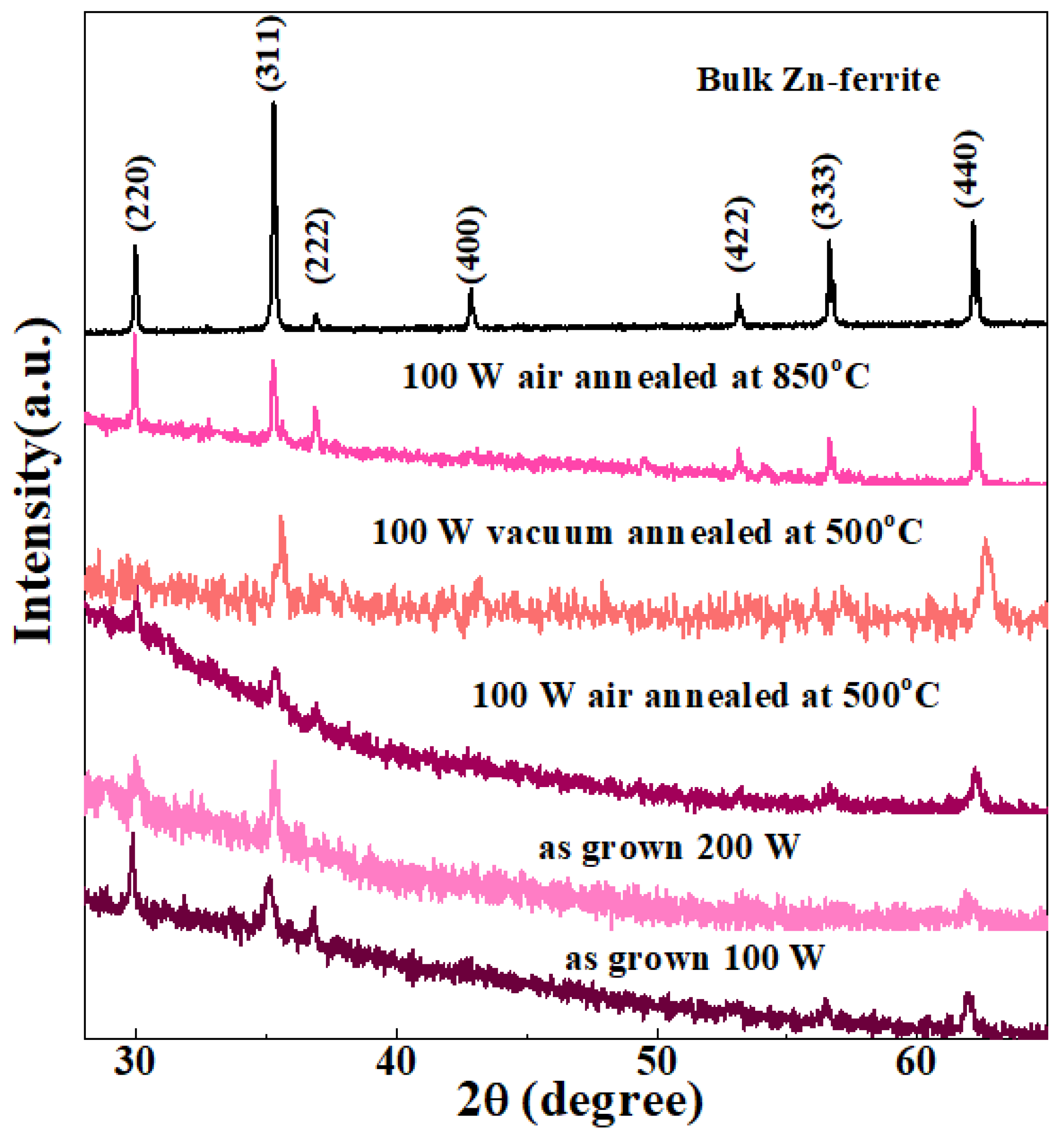

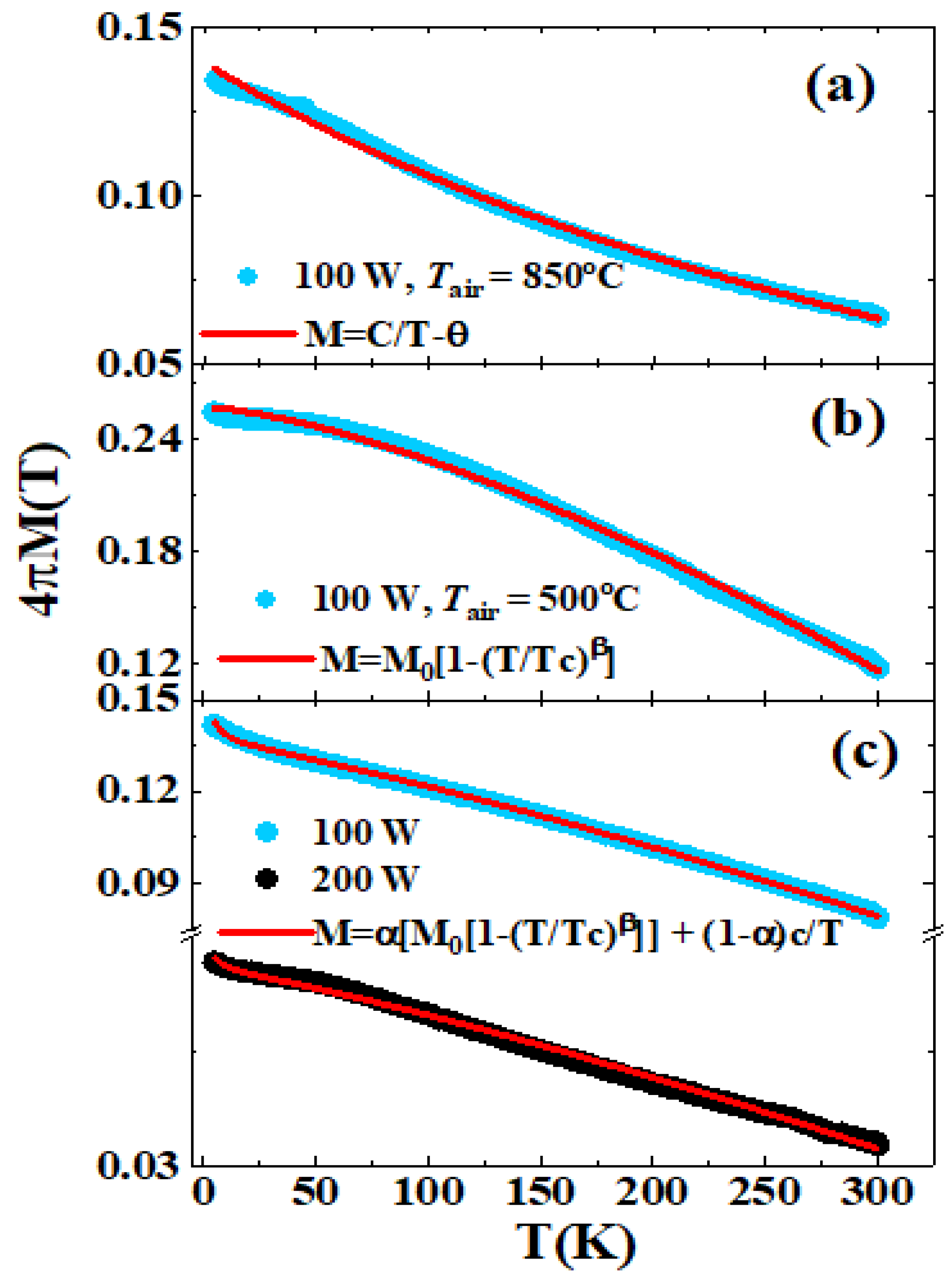
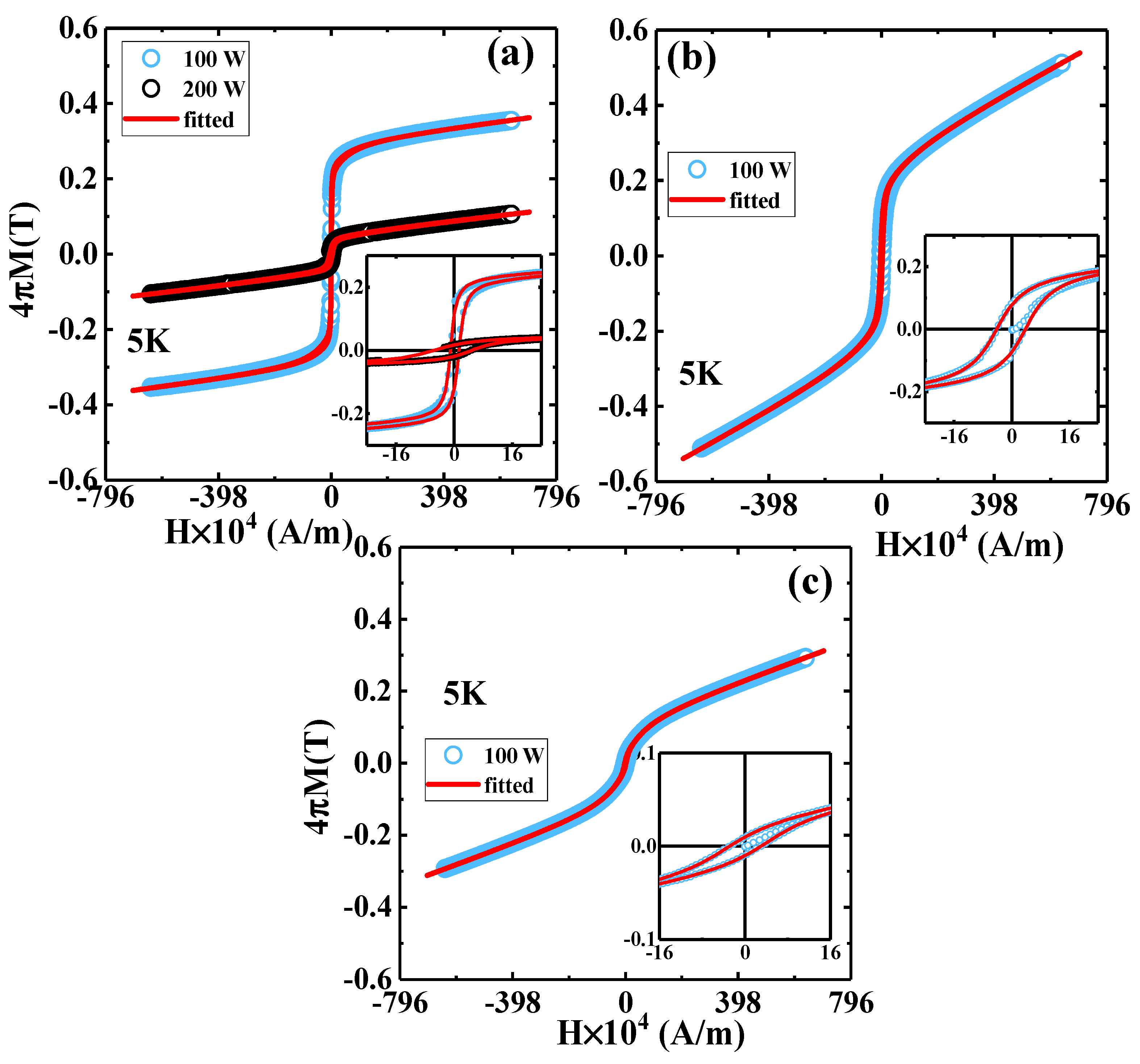
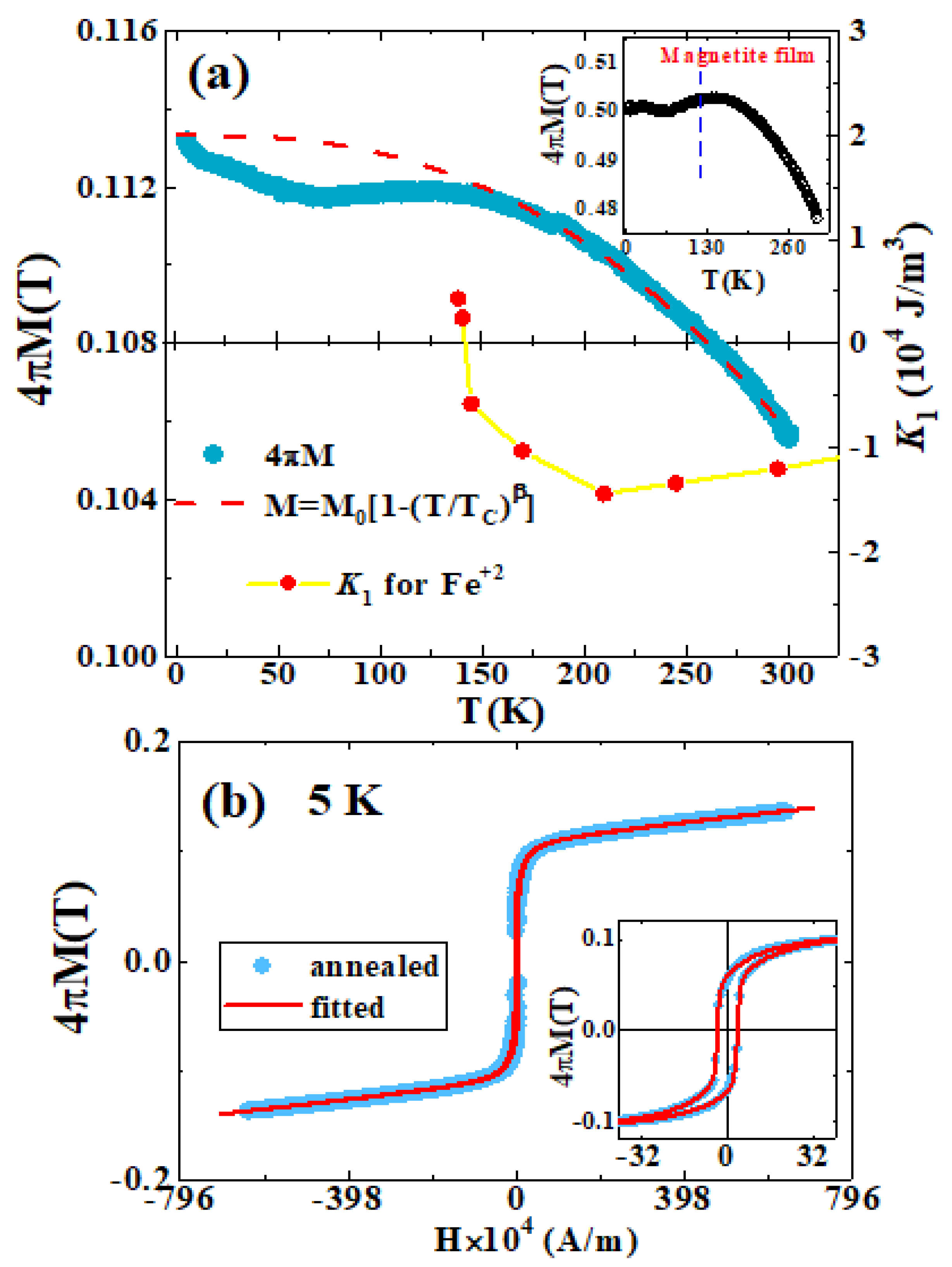
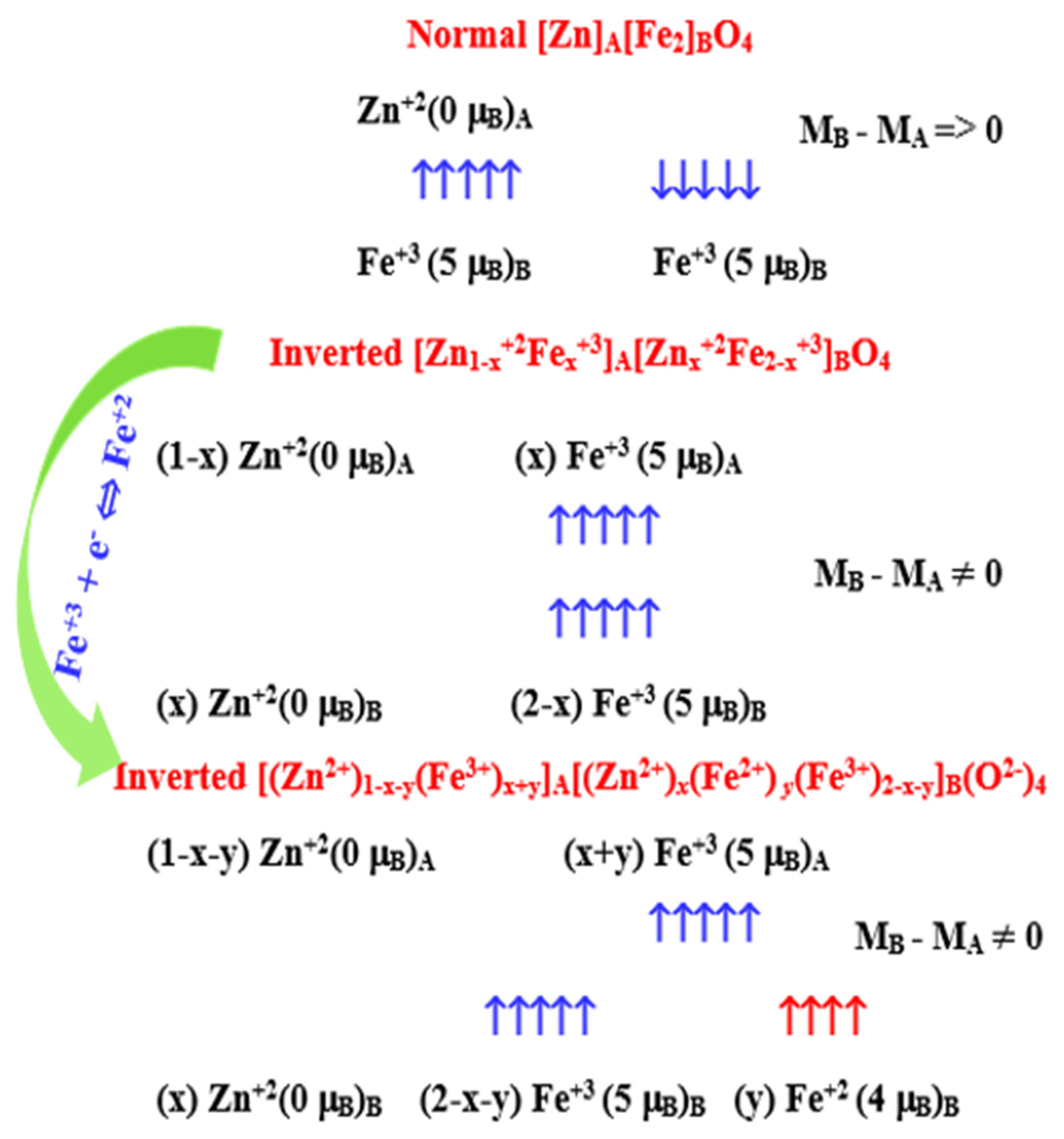
| Sample | Lattice Constant (Å) | Grain Size (nm) | β | TC or θ (K) | α |
|---|---|---|---|---|---|
| as-grown 100 W | 8.46 | 24 | 1.25 | 604 | 0.85 |
| as-grown 200 W films | 8.43 | 30 | 1.25 | 600 | 0.8 |
| 100 W films air annealed at 500 °C | 8.43 | 31 | 1.45 | 452 | 1 |
| 100 W films air annealed at 850 °C | 8.44 | 58 | - | 254 | 0 |
| 100 W films vacuum annealed at 500 °C | 8.41 | 41 | 2.5 | 828 | 1 |
| Sample | HC1 (kA/m) | HC2 (kA/m) | MSf1 (T) | MSf2 (T) | S1 | S2 | α1 | α2 | 1 − α1 − α2 | χf |
|---|---|---|---|---|---|---|---|---|---|---|
| as-grown 100 W | 9.55 | 92.95 | 0.35 | 0.19 | 0.34 | 0.25 | 0.597 | 0.402 | 0.001 | 473 |
| as-grown 200 W | 45.67 | 446.111 | 0.048 | 0.02 | 0.20 | 0.13 | 0.984 | 0.001 | 0.016 | 0.47 |
| 100 W air annealed at 500 °C | 38.28 | 42.73 | 0.39 | 0.21 | 0.31 | 0.17 | 0.251 | 0.636 | 0.112 | 0.32 |
| 100 W air annealed at 850 °C | 14.40 | 36.37 | 0.16 | 0.13 | 0.06 | 0.03 | 0.105 | 0.722 | 0.173 | 0.13 |
| 100 W vacuum annealed at 500 °C | 35.5 | 32.06 | 0.063 | 0.16 | 0.15 | 0.41 | 0.452 | 0.52 | 0.003 | 0.12 |
Publisher’s Note: MDPI stays neutral with regard to jurisdictional claims in published maps and institutional affiliations. |
© 2022 by the authors. Licensee MDPI, Basel, Switzerland. This article is an open access article distributed under the terms and conditions of the Creative Commons Attribution (CC BY) license (https://creativecommons.org/licenses/by/4.0/).
Share and Cite
Bohra, M.; Battula, S.V.; Singh, N.; Sahu, B.; Annadi, A.; Singh, V. Competing Magnetic Interactions in Inverted Zn-Ferrite Thin Films. Magnetism 2022, 2, 168-178. https://doi.org/10.3390/magnetism2020012
Bohra M, Battula SV, Singh N, Sahu B, Annadi A, Singh V. Competing Magnetic Interactions in Inverted Zn-Ferrite Thin Films. Magnetism. 2022; 2(2):168-178. https://doi.org/10.3390/magnetism2020012
Chicago/Turabian StyleBohra, Murtaza, Sai Vittal Battula, Nitesh Singh, Baidyanath Sahu, Anil Annadi, and Vidyadhar Singh. 2022. "Competing Magnetic Interactions in Inverted Zn-Ferrite Thin Films" Magnetism 2, no. 2: 168-178. https://doi.org/10.3390/magnetism2020012







